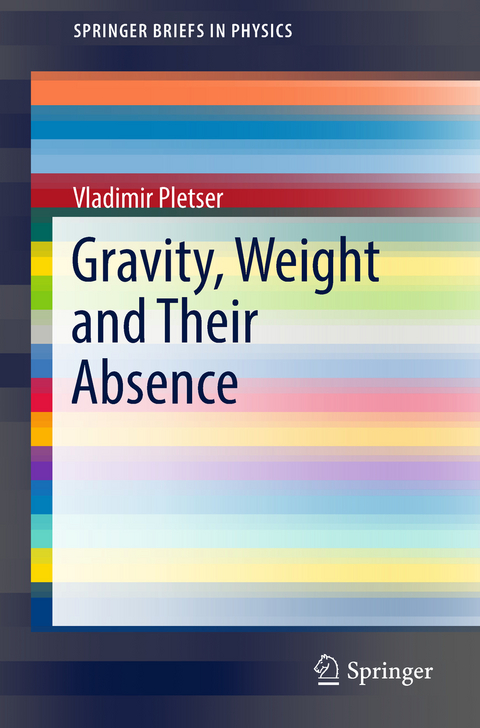
Gravity, Weight and Their Absence
Springer Verlag, Singapore
978-981-10-8695-3 (ISBN)
The book introduces readers to the concept of weightlessness and microgravity, and presents several examples of microgravity research in fluid physics, the material sciences and human physiology. Further, it explains a range of basic physical concepts (inertia, reference frames, mass and weight, accelerations, gravitation and weightiness, free fall, trajectories, and platforms for microgravity research) in simple terms. The last section addresses the physiological effects of weightlessness. The book’s simple didactic approach makes it easy to read: equations are kept to a minimum, while examples and applications are presented in the appendices. Simple sketches and photos from actual space missions illustrate the main content. This book allows readers to understand the space environment that astronauts experience on board space stations, and to more closely follow on-going and future space missions in Earth orbit and to Mars.
Vladimir Pletser earned his M. Eng. in Mechanics in 1979, M.Sc. in Geophysics in 1980 and a Ph.D. in Astrophysics in 1990, all at the University of Louvain, Belgium. Since April 2016, he has been a visiting professor – scientific adviser at the Chinese Academy of Sciences in Beijing’s Technology and Engineering Centre for Space Utilization, supporting the preparation and development of microgravity research instrumentation for parabolic flights and for the future Chinese Space Station. He previously worked for 30 years as a senior physicist – engineer at the European Space Research and Technology Centre (ESTEC) of the European Space Agency (ESA), where he was in charge of developing scientific instruments for microgravity research in fluid physics, crystallisation of proteins and zeolites and on dexterous manipulation on board the International Space Station. At ESA he was also responsible for the aircraftparabolic flight microgravity research programme and he logged more than 7350 parabolas, representing almost 40 hours of weightlessness, equivalent to 26 Earth orbits, and 53 min and 50 min at Mars and Moon g levels, during which he participated in several hundred experiments in physical and life sciences. He holds the official Guinness World Record for the number of airplanes (12) on which he has flown parabolas. He is currently a flight instructor for public for discovery parabolic flights. An astronaut candidate for Belgium since 1991, he was payload specialist candidate for several spacelab missions, including Spacelab LMS for which he spent two months in training at NASA-JSC, Houston in 1995. He was an astronaut training instructor for parabolic flights for ESA astronauts and for NASA and DLR astronauts for several spacelab missions. In 2001 he was selected by The Mars Society, a private organisation promoting the human explorationof Mars, to participate in three international Mars mission simulations: in the Arctic Circle in 2001 and in the Desert of Utah in 2002 and as crew commander in 2009. He is visiting professor at 20 universities in Europe, USA, Canada, Africa, Israel, and China. He has more than 600 publications, including 13 books and book chapters, 60 articles in refereed journals and 130 articles in international conferences proceedings. He has given more than 600 presentations and conferences. He is a member of the International Astronautical Academy and of several other academies and scientific organisations.
Part I: Can inertia make us move? Introduction.- Inertia and inertial reference frames.- Gravitation and weightiness.- Part II: Is weightlessness without gravity? Introduction to Part II Free fall and weightlessness.- Free fall trajectories.- Free fall in the Universe.- Part III: Should one dwell on microgravity? Introduction to Part III Microgravity.- Means to generate microgravity.- Interest of microgravity.- Part IV: Physiological effects of weightlessness Introduction to Part IV General considerations on Life science research.- Physiological effects of weightlessnes.- Bone demineralization.
| Erscheinungsdatum | 18.07.2018 |
|---|---|
| Reihe/Serie | SpringerBriefs in Physics |
| Zusatzinfo | 27 Illustrations, color; 13 Illustrations, black and white; XIII, 88 p. 40 illus., 27 illus. in color. |
| Verlagsort | Singapore |
| Sprache | englisch |
| Maße | 155 x 235 mm |
| Themenwelt | Studium ► 1. Studienabschnitt (Vorklinik) ► Physiologie |
| Naturwissenschaften ► Physik / Astronomie ► Festkörperphysik | |
| Naturwissenschaften ► Physik / Astronomie ► Mechanik | |
| Technik ► Fahrzeugbau / Schiffbau | |
| Technik ► Luft- / Raumfahrttechnik | |
| Schlagworte | Absence of gravity • Absence of weight • Aircraft parabolic flights • Bone demineralization • Drop tower • Gravitational attraction • Long term space mission • Physiological effects • Referential frames • Sounding rockets • Superficial tension |
| ISBN-10 | 981-10-8695-8 / 9811086958 |
| ISBN-13 | 978-981-10-8695-3 / 9789811086953 |
| Zustand | Neuware |
| Haben Sie eine Frage zum Produkt? |
aus dem Bereich


